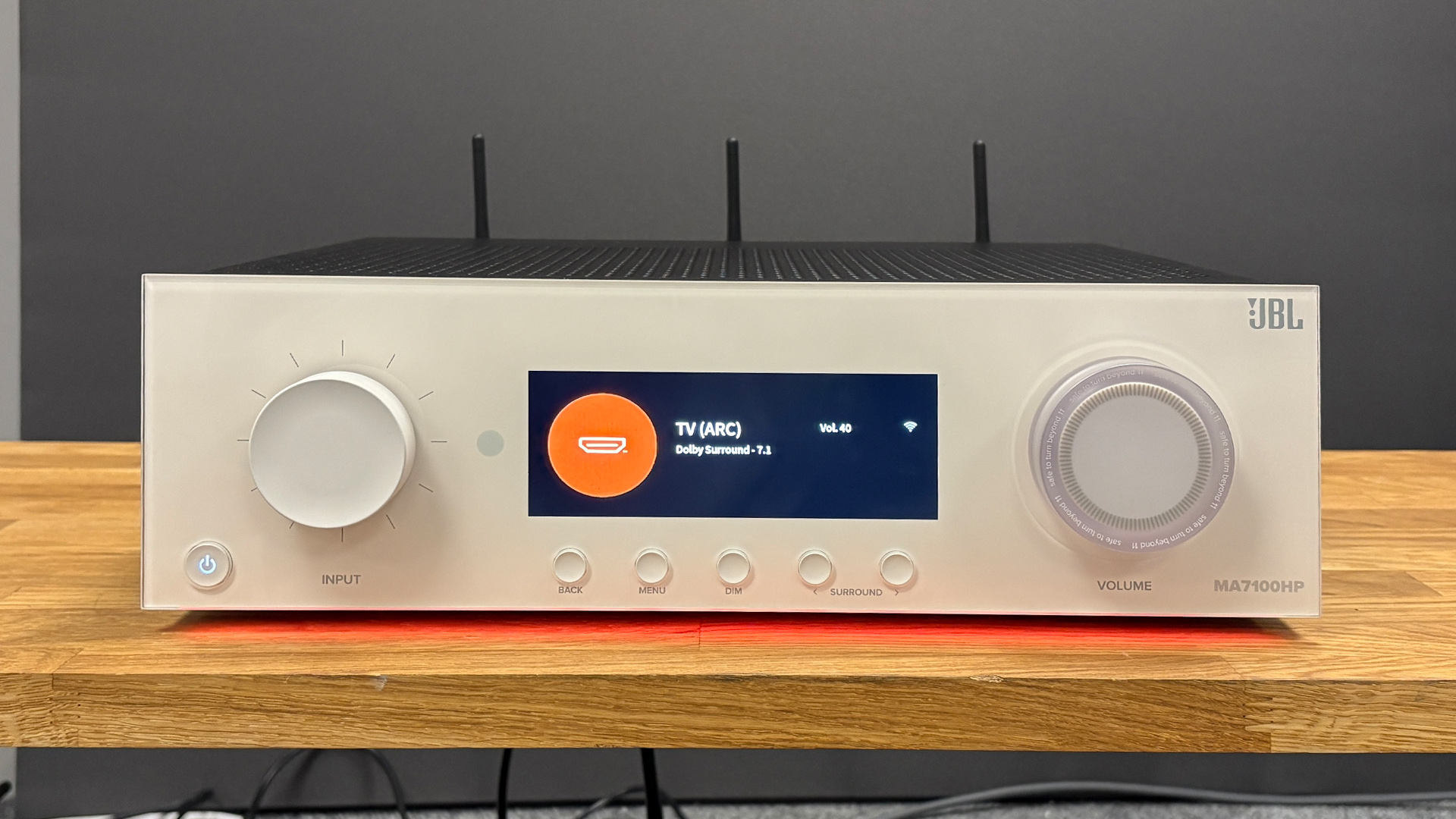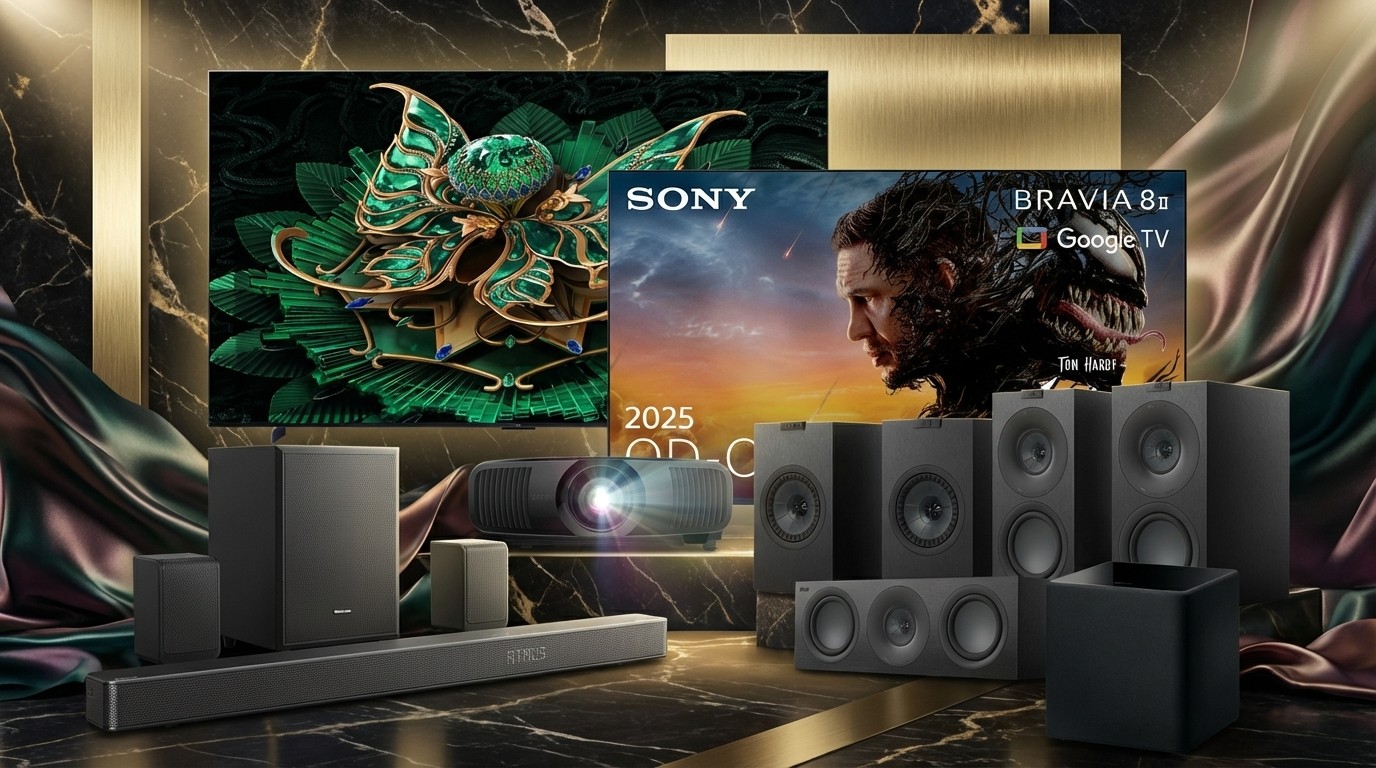What Hi-Fi? Verdict
Despite its big and bold sound, MA7100HP’s stunted dynamics and middling detail levels mean it can’t challenge its Denon and Sony rivals
Pros
- +
Expansive and bold sound
- +
Solid feature set
- +
Display and on-screen menus appreciated
Cons
- -
Lacking in detail and nuance
- -
Dynamically limited and synthetic presentation
- -
Needlessly complicated app
Why you can trust What Hi-Fi?
When JBL announced its latest range of home cinema AVRs, there was a collective sense of excitement throughout the What Hi-Fi? AV team.
Denon has ruled the roost with very little competition for a long while now, dominating the entry-level and mid-range markets with its excellent X-series of home cinema amplifiers.
JBL’s mission is simple; the Modern Audio series is an accessible line of AVRs aimed towards those looking to dabble in home cinema audio or graduate from a soundbar. Likewise, JBL hopes to entice seasoned cinematic audiophiles, which is a tricky balance, though the five-strong lineup of amplifiers should cover most bases.
We have the MA7100HP here today, which serves as the step-down model from the flagship, and it has a promising feature list on paper, too, but the most important factor is – no surprises here – sound quality. With a small yet talented cohort of competitors in this area, the MA7100HP must excel. So, does it?
Price
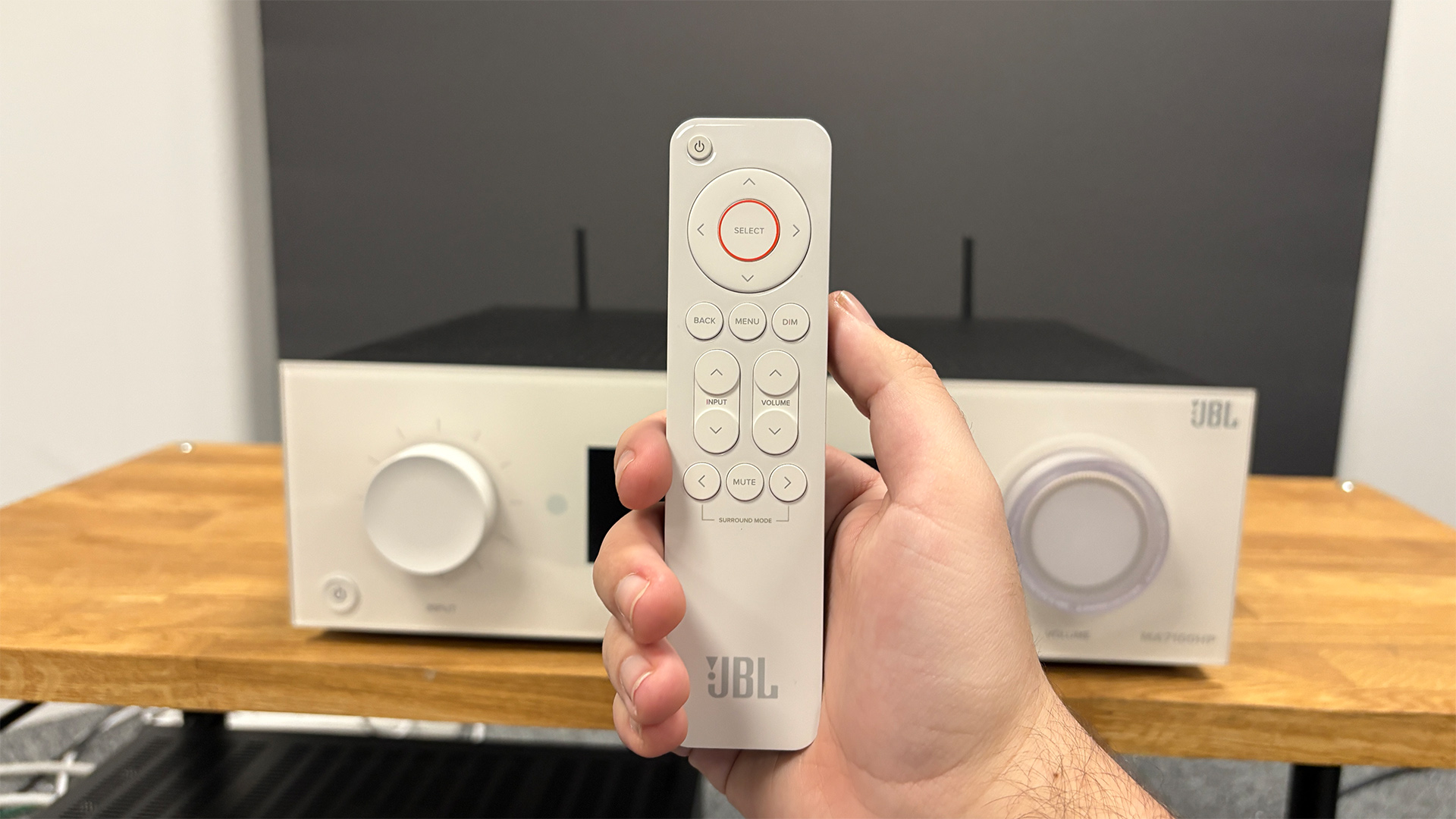
The JBL MA7100HP is priced at £1399 / $1199 / AU$2055, putting it into the mid-range sector of the AVR market, where the five-star Denon AVC-X3800H looms large.
Some notable alternatives undercut the MA7100HP too, including the Sony TA-AN1000 (£999 / around $1240 / AU$1850) and Denon AVR-X2800H (£869 / $1200 / AU$2399) – both of which are now heavily discounted at many retailers. Need we also remind you that both the Sony and Denon are previous What Hi-Fi? Award winners, so the competition is piping hot.
If we’re being honest, the JBL feels a touch overpriced for our liking – especially when we take the build quality and feature set into account compared to its aforementioned peers.
The latest hi-fi, home cinema and tech news, reviews, buying advice and deals, direct to your inbox.
Build
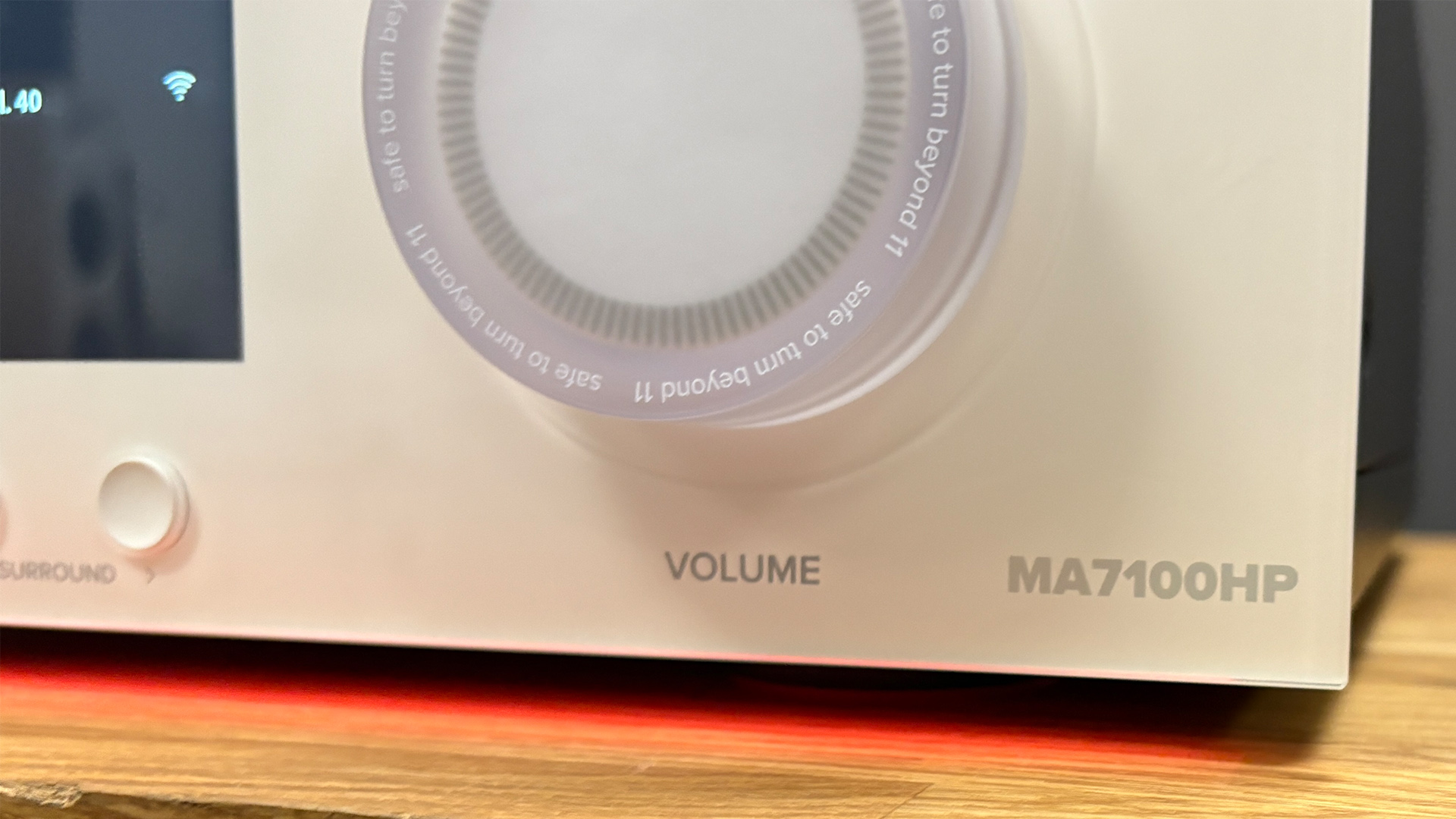
We’re not entirely convinced by the JBL’s build as, while it's unique compared to the fairly uninspired-looking Denon models in our test room, we wouldn’t consider it to be to our collective taste.
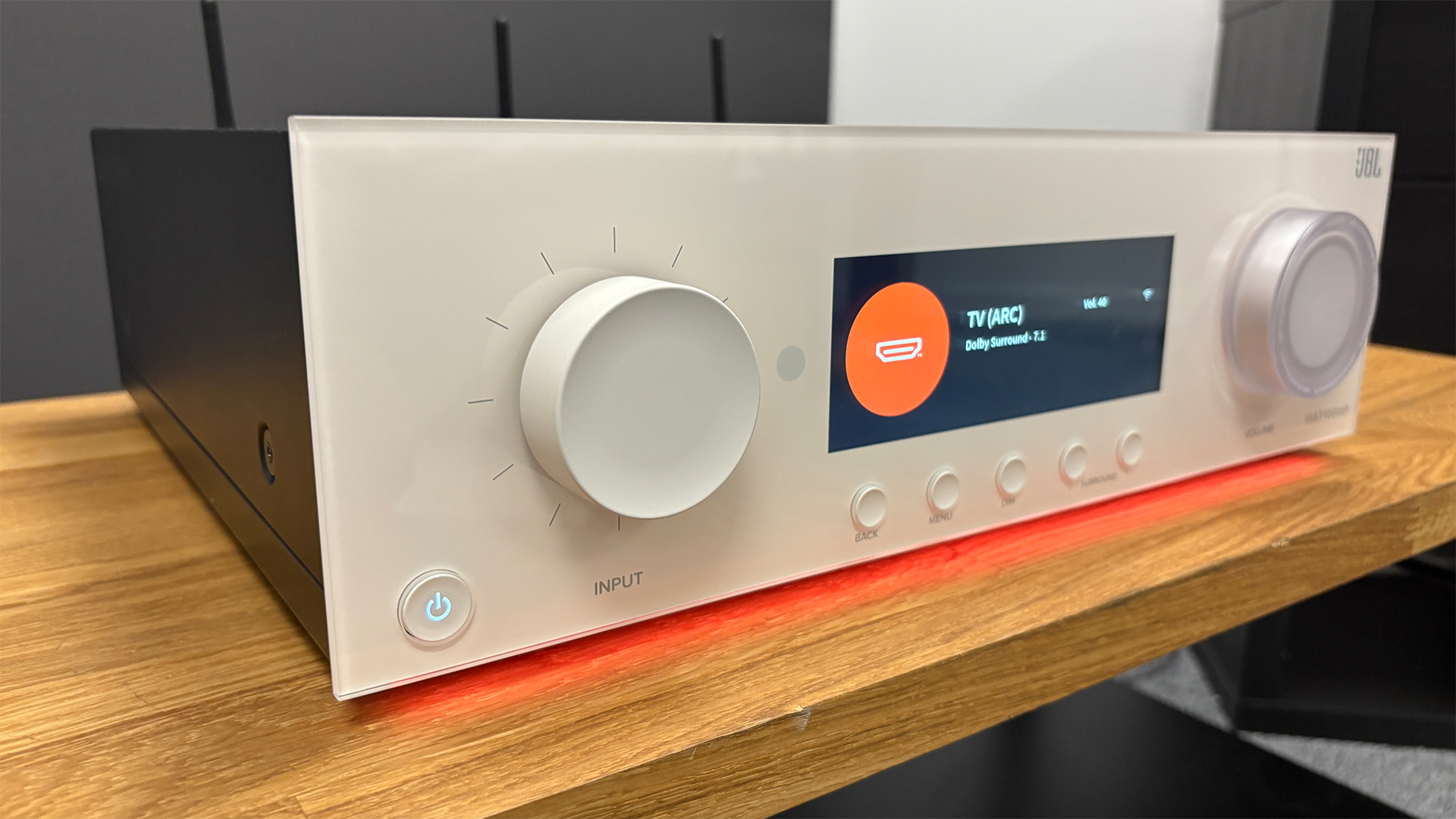
HDMI inputs x 6
HDMI outputs x 2
ARC/eARC eARC
HDMI 2.1 features 4K/120Hz, 8K/60Hz, VRR, ALLM, QMS on three rear HDMI inputs
Amplification 7 channels
HDR formats HDR10, HDR10+, HLG, Dolby Vision
Audio formats Dolby Atmos, Dolby TrueHD, DTS:X
Streaming AirPlay 2, Google Chromecast, Bluetooth
Voice assistant N/A
We’ll start with the positives; the display on the front is a really nice touch – especially when you stream music to the AVR as it shows album artwork, track listing and a 'play bar' akin to a premium music streamer. It also makes navigating the system menus a breeze, though these menus are handily mirrored on your connected TV or projector.
Furthermore, the customisable LED light strip along the bottom of the unit adds a pop of colour, and it can be disabled if you have an aversion to ambient light.
Flipping the unit around, we appreciate how straightforward the set-up is; you’ll find neatly laid-out ports that are all clearly labelled. This should make set-up very easy, even for those not au fait with home cinema receivers.
The AVR is also available in two finishes – black and white – and the cheeky nod to This Is Spinal Tap that adorns the volume knob is also a fun Easter egg.
That all being said, we find that the MA7100HP doesn’t feel particularly premium to the touch.
At 7.6kg, the JBL is much lighter than the Sony TA-AN1000 or Denon AVR-X2800H; and while that isn’t necessarily an issue, it just makes the JBL feel slightly cheap despite it costing considerably more than both of those models.
And, while the edgy orange accents might suit some people’s taste, and we certainly can’t knock JBL’s effort to create something unique that’s not just another black cuboid, it certainly won’t appeal to everyone.
Features
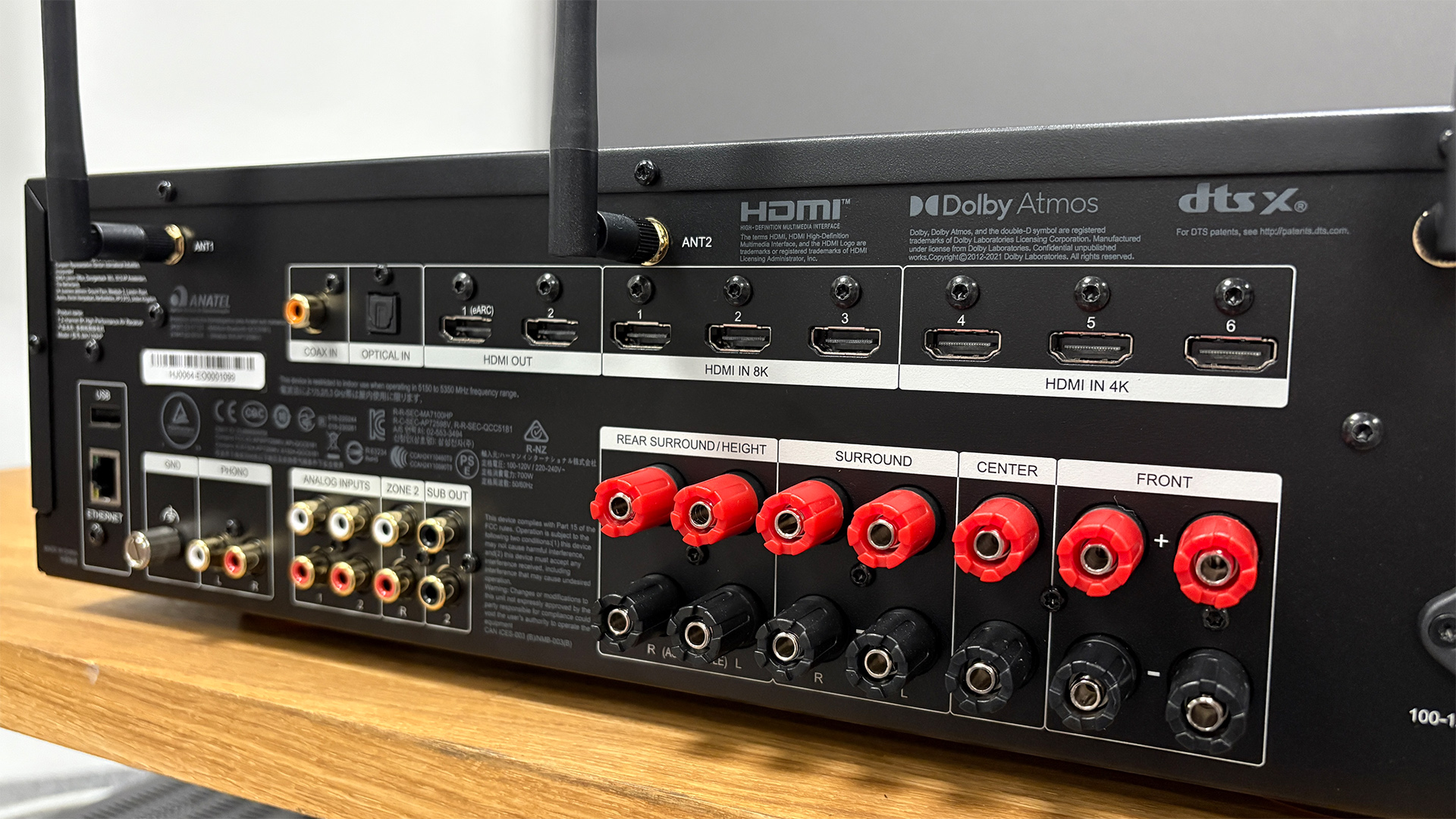
This home cinema receiver features seven channels of Class D amplification and two subwoofer outputs, meaning it can support up to a 7.2 surround-sound system or 5.2.2 Dolby Atmos system.
This is on par with its Sony, Denon and Arcam competitors, and means you’ll need to step up to the JBL MA9100HP if you have a larger system such as a 7.2.2 speaker package with rear surrounds and height channels. Sound format support includes all of the usual suspects, including Dolby Atmos and DTS:X.
JBL claims 125W of power output with two channels driven, which is considerably higher than the Sony and Denon (85W and 95W, respectively), and less than the Denon AVC-X3800H’s claimed 180W power output.
There are a total of six HDMI inputs, three of which are the 2.1 standard that support 8K/60Hz or 4K/120Hz sources with VRR and ALLM. All inputs support HDR10, HDR10+ and Dolby Vision, too, while the dual outputs feature HDMI eARC connectivity and Zone 2 functionality.
There is also a built-in moving magnet phono connection for hooking this AVR up to a turntable, alongside coaxial, optical and USB digital audio inputs, and RCA line-level analogue inputs. Wireless connectivity is solid, with Apple AirPlay 2, Google Chromecast and Bluetooth with support for the aptX Adaptive codec.
JBL has also taken an unconventional and, if we’re being brutally honest, frustrating approach to room correction.
You’ll need to download the EZ EQ app, which is different from the JBL Premium Audio app that’s required to stream music and connect devices via Bluetooth.
From there, the app requires you to correct each speaker individually (front, centre and surrounds) by walking around the room with your iPhone’s microphone (tough luck if you have an Android smartphone, as you’ll need to buy an external microphone).
There’s a catch to this process, however: it doesn’t set speaker distances or levels, you’ll need to do that yourself. The Sony and Denon receivers, on the other hand, have intuitive microphone-driven auto calibration systems that handle this for you.
It’s a strange omission considering that JBL is attempting to make this a user-friendly home cinema amp. This amplifier is Dirac Live Ready, though that process is a lot more involved and incurs additional costs.
Sound

This is the make-or-break category for any home cinema receiver, so does the JBL deliver? Unfortunately, we’re not entirely convinced it does. We’ve hooked the amplifier up to our reference speaker package – the PMC Twenty5.23 package in a 7.2 configuration – and raided our 4K Blu-ray shelf for a collection of reference discs including Interstellar, Blade Runner 2049, Oppenheimer and Dune: Part Two.
There are positive aspects to the MA7100HP, namely its big and bold sound characteristics. For scenes that require sheer brawn and scale, the JBL can deliver a punchy, room-filling sound with ease, which is shown off in the rip-roaring introduction montage of Top Gun: Maverick.
It also does a solid job of tracking the positions of the fighter jets as they speed down the aircraft carrier and soar into the sky, with effects passing seamlessly between channels.
Speaking of which, the MA7100HP manages to create a harmonious balance between each channel in a convincing surround-sound effect, with no noticeable gaps between the speakers to detract from the immersive bubble of sound.
Finally, it produces a solid, weighty kick of bass when needed, with plenty of punch and heft. We’d hesitate to compliment its bass control, but if you’re after sheer low-end rumble, then this JBL is capable of delivering.
Unfortunately, that’s really where the positives end, as elsewhere the JBL just misses the mark.
There is an overall sense that the 7100HP is lacking in subtlety, as the spacious sound comes at the expense of finer sonic details.
Low-level dynamics, for instance, are a notable weakness, which leads to flat and unengaging dialogue. The strained conversation between Cooper and Brand, as they realise that the minutes they’ve spent waiting for their waterlogged engines to reboot equate to years in Earth-time in Interstellar, should be conveyed with desperation and panic – but the JBL doesn’t quite capture this.
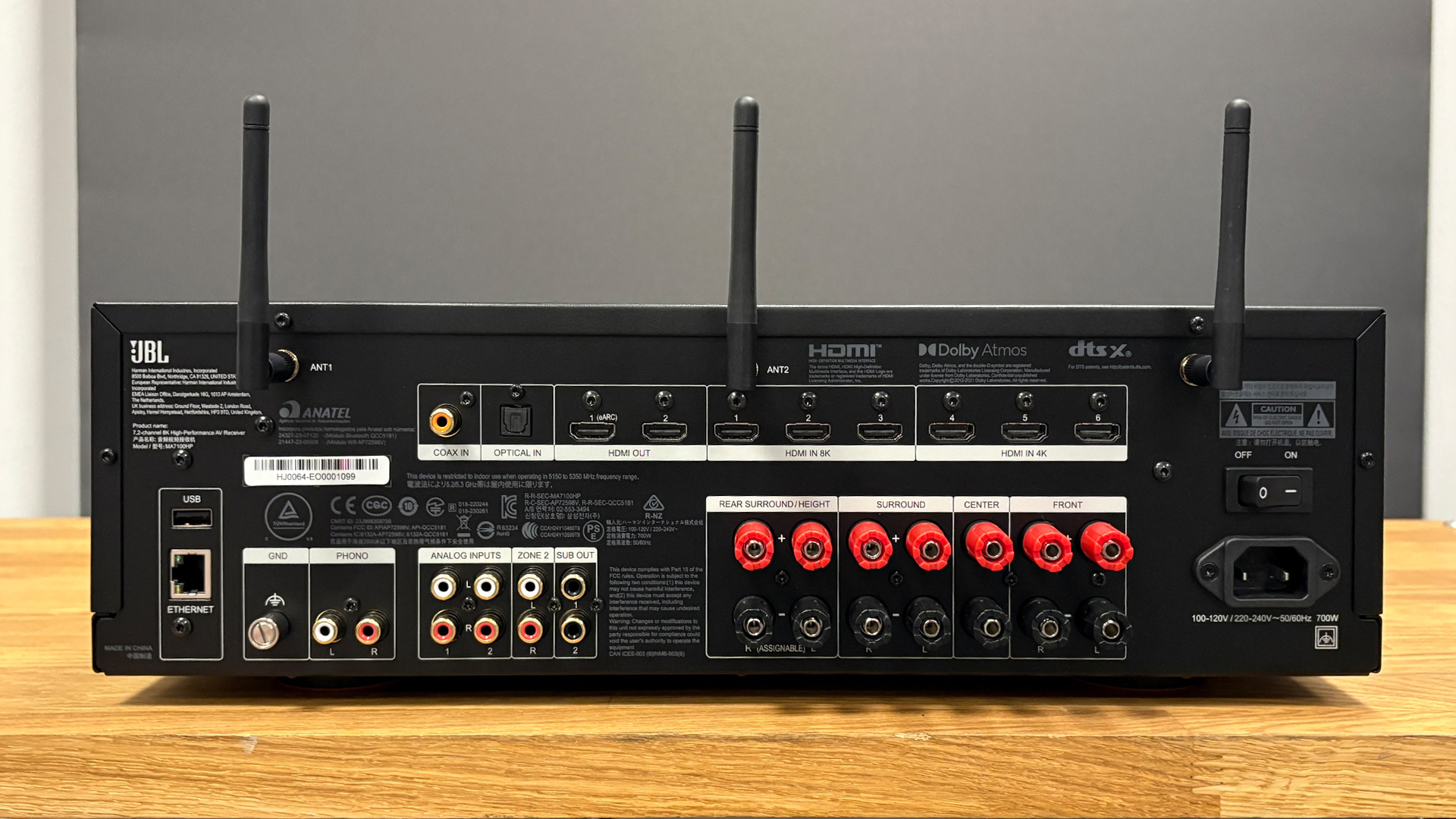
Sticking with Interstellar, we take issue with synthetic-sounding effects – specifically the waves that lap against the hull of the Endurance space shuttle. There is a metallic quality to the water that’s accentuated when a character steps through it, causing unnatural-sounding splashes.
Furthermore, the overall sound of this AVR can be best described as mushy, with a noticeable shortcoming when it comes to definition and detail.
There is a congested nature to the audio, which means that dialogue is often lost in scenes with many competing effects. The bustling Fremen party in Dune: Part Two, during which Paul Atriedes is granted the Muad’Dib title, is a prime example, as crucial pieces of dialogue are mixed up in the general hustle and bustle of the tent.
Switching to some music in stereo, the JBL’s issues persist, with Taylor Swift’s The 1 and Bombay Bicycle Club’s Luna both sounding fine, but by no means particularly engaging or inviting.
We pair the MA7100HP with JBL's own Stage 2 loudspeakers to see if the synergy between the AVR and speakers improves the experience.
While you don’t necessarily have to pair these together, they were developed in tandem to suit each other when it comes to sound characteristics. Ultimately, though, we find the issues to persist, with scale and punch presented at the expense of subtlety and detail.
While these sonic shortcomings are certainly an issue in isolation, they become even more apparent when we put the JBL side-by-side with the Award-winning Sony TA-AN1000.
Considering the Sony costs considerably less, there is no competition when it comes to sound quality. The Sony’s expert handling of dynamics and more detailed sound seal the deal, while the comparatively expansive soundstage makes it the obvious choice.
Verdict
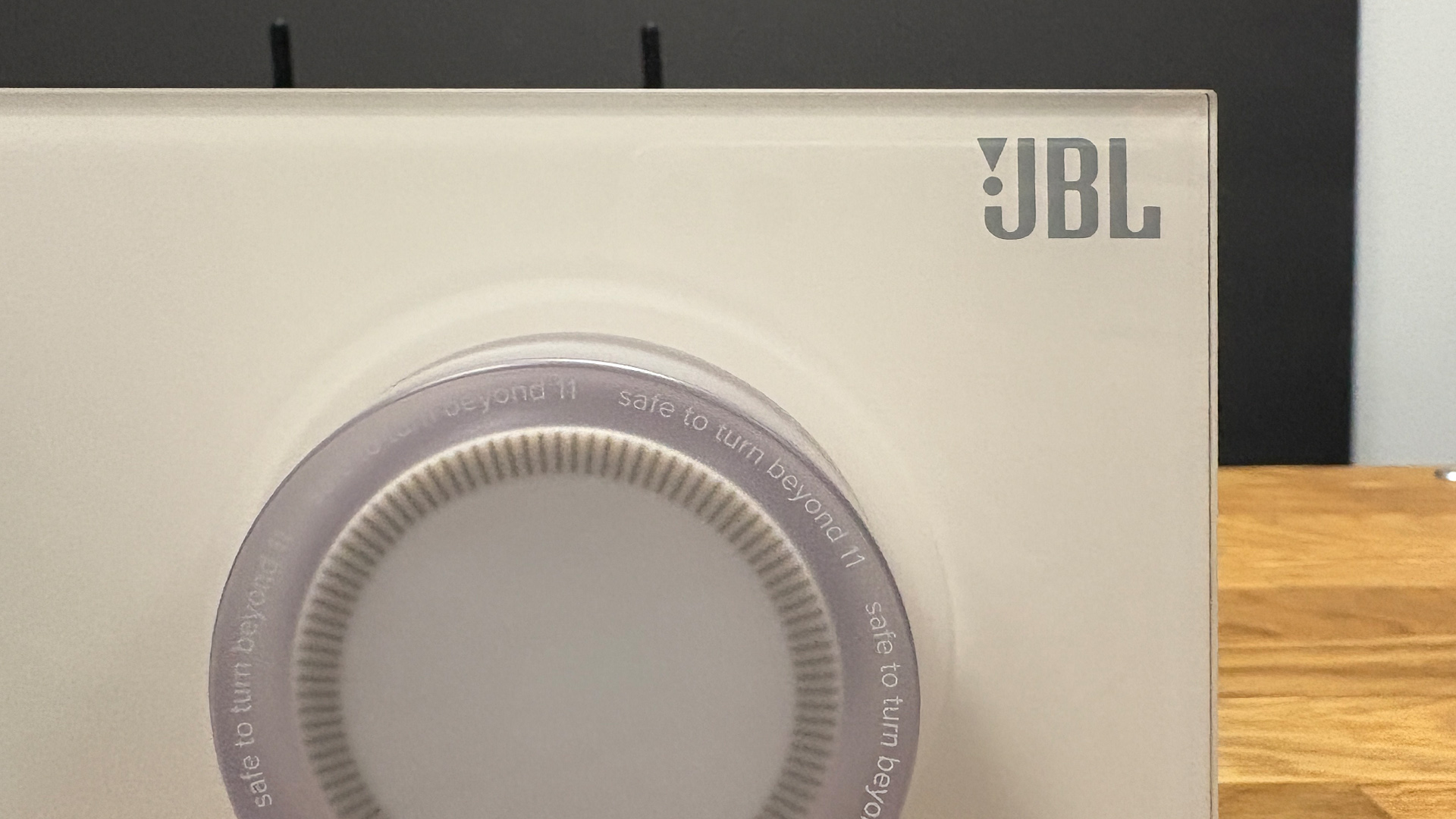
The JBL MA7100HP isn’t a complete write-off, thanks to its big, bold and encompassing sound. However, it's not a home cinema receiver that we can really recommend.
The sub-par detail, weak dynamics and lack of sonic subtlety hinder its true potential, and it likely won’t be enough to tempt die-hard soundbar fans to join the world of true home cinema sound.
SCORES
- Sound 3
- Features 4
- Build 3
MORE:
Read our review of the Arcam AVR5
Also consider the Sony TA-AN1000
Read our Denon AVR-X2800H
Best AV receivers: the top home cinema amplifiers we've tested
Lewis Empson is a Senior Staff Writer on What Hi-Fi?. He was previously Gaming and Digital editor for Cardiff University's 'Quench Magazine', Lewis graduated in 2021 and has since worked on a selection of lifestyle magazines and regional newspapers. Outside of work, he enjoys gaming, gigs and regular cinema trips.
- Ketan BharadiaTechnical Editor
You must confirm your public display name before commenting
Please logout and then login again, you will then be prompted to enter your display name.
